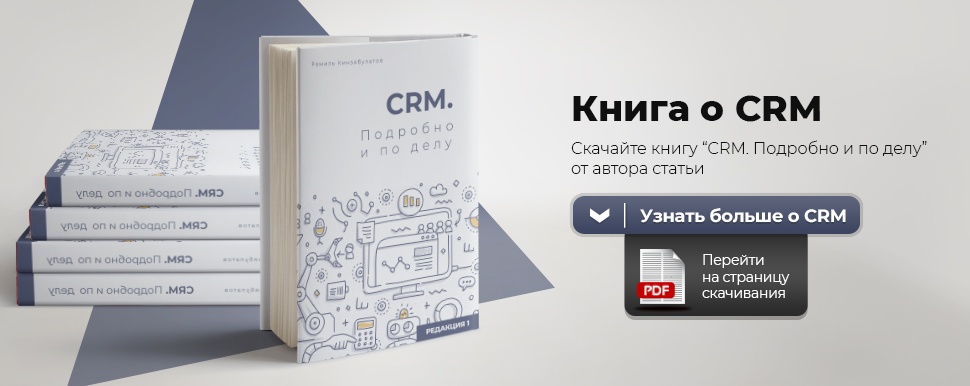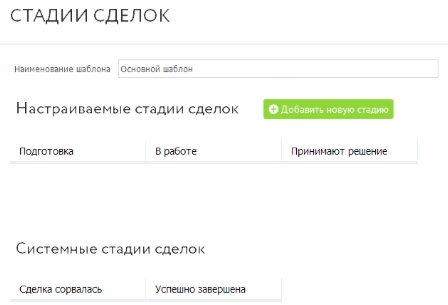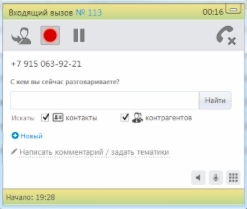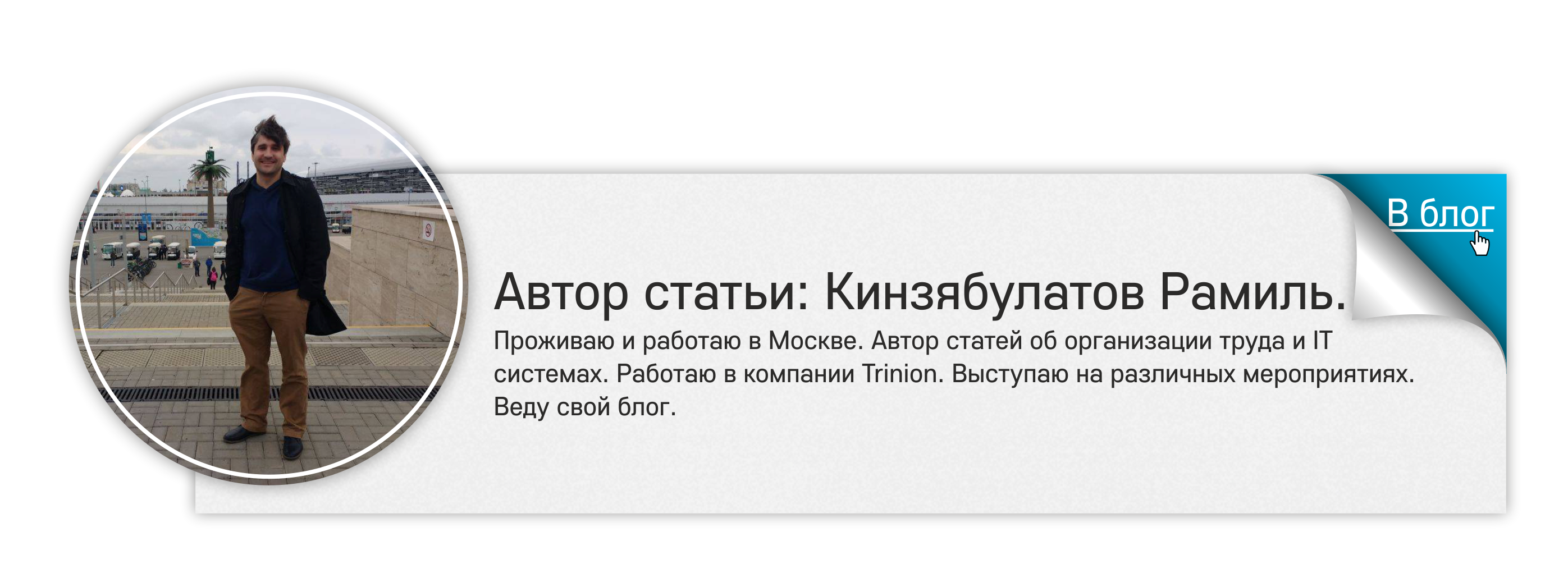Mango CRM System Overview
 I have written several reviews of various CRM systems represented on the Russian market, and as part of preparing a comparative table for all the CRMs I described, another one will be considered - CRM Mango Office.
I have written several reviews of various CRM systems represented on the Russian market, and as part of preparing a comparative table for all the CRMs I described, another one will be considered - CRM Mango Office.Some of my clients use Mango's telephony, but none of them use Mango CRM — the product of the same company — to manage customer relationships. Often, Mango telephony is integrated with completely different CRM systems, although information on the CRM system is presented on the company's website, and it would be logical to pay attention to the CRM system from one supplier when buying telephony.
The very fact that the CRM-system "grew" from telephony makes you think about the quality of its other parameters inherent in CRM. And at first glance it seems that this is such a tricky move to attract customers interested in telephony, and also buy CRM. If you look at the site of Mango and refer to customer reviews about CRM, then we will not see almost a single response to the customer relationship management system itself, most of them are related exclusively to telephony. However, we will not make hasty conclusions and see what the CRM Mango Office is.
')
Licensing and tariffs
CRM Mango Office is a “semi-descript”, as I call it, system. That is, to start working with it you need to install the program on your computer. (This system, by the way, works only in Windows). However, CRM does not operate in offline mode: for its operation, it is required not only to install the program, but also to connect to the Internet. Therefore, to call it completely desktop would be wrong.
So, the program is installed on the computers of all users. Each user logs in using their personal data: username and password. These data, as well as information about the users themselves and their rights, are recorded in the Administration - Users section.
 As for the cost, we can say that CRM Mango Office is a very budget system. It is offered in two tariffs, the functionality of which is not fundamentally different:
As for the cost, we can say that CRM Mango Office is a very budget system. It is offered in two tariffs, the functionality of which is not fundamentally different:- The “Division” tariff is designed for 6 users, the cost is 2000 rubles per month.
- The tariff “Office” is designed for 12 users, the cost is 4500 rubles per month.
Interface
The system interface is quite concise and simple. It is a tape containing system modules. The main modules are displayed in the ribbon, additional ones are hidden under the icon of the list. There are not many modules, so the interface is not overloaded at all.

It is worth noting a small, but very functional option: when you hover the mouse over any of the modules, the + sign appears, and when you click on it, you can create a new entry in this module. In such a quick way, you can create a counterparty, a transaction, a process, a communication, a task.
The bottom ribbon contains quick action buttons (telephony buttons for dialing and an e-mail client for quickly sending letters), as well as a log of recent calls and a log of missed calls.

System components
Now let's take a closer look at the modules that make up the CRM Mango Office. We will discuss only those modules that are directly related to working with the client:
- Counterparties
- Contacts
- Deals
- Processes
- Communications
- Tasks
When you open each of these modules, you will see lists containing records corresponding to the module. All these lists are customizable: here you can display exactly the data that is relevant in the first place.
As for the module cards: they have a fairly rigid structure, their appearance cannot be changed (except by disabling data that is not needed). But it is possible to add your own fields to each of the modules.
All modules are closely related to each other. For example, from the Transaction Card, you can create a counterparty, and start the communication, the task, and the process. And so with each of the modules. We proceed to consider the first module.
Counterparties
Counterparties in CRM Mango Office are both physical and legal entities with which the company cooperates.
The list of counterparties is organized fairly standardly. Directly from the list, you can perform some actions without entering the client card:
- to call
- to send a letter
- change customer view
- edit responsible
When creating a new contractor, it is necessary to fill in the data: Name, Type of contractor, Legal status, Contact information (Name, Phone, Email of the contact person), Details, Current account.

In this case, the required fields are Name, Contact Name and Phone. It is not possible to make other fields mandatory, which is not very good. Obviously, such data as the type of client should be mandatory, so that in future you can display the analytics on conversion. You can add your fields to the counterparty card (as in the cards of other modules), the addition mechanism is quite simple.
After the new counterpart has been created, the tabs appear in its card: Processes, Transactions, Communications, Tasks, Documents - in which the entire history of working with this client will be stored. Such an opportunity to view the full information on the client in his card is the standard of any CRM system.

We have already raised the issue of the types of counterparty. Consider it in more detail. There are 3 types of counterparties in CRM Mango Office:
- Customer
- Potential client
- Agent
I will not stop repeating from article to article that such an entity as Lead is mandatory for any CRM system. And the concept of Potential customer as one of the types of counterparty is not able to replace it. Yes, a lead is a potential client, but it is a separate entity of a CRM system, with which a completely different work is being carried out, rather than with a counterparty.
Working with the existing concept of “potential client” in CRM Mango Office is not thought out. Let me explain why:
- As I noted above, the Type of Counterparty field is not mandatory, therefore the View may simply not be specified due to the human factor, and accordingly, some of the leads will necessarily be overlooked.
- There is no report on the conversion of leads into customers in the system, and there is no possibility to set up such a report either, although the change history for the counterparty is stored in the system. If there is no such report, then it is not possible to trace the effectiveness of the work of managers.
As for the two other types of counterparties, the situation is as follows. All customers are in the same category (which is called Customers) without gradation (in wholesale-retail, for example).
The presence of this type of counterparty as an Agent surprised me. Here is what is written in the CRM Mango Office System User Guide: “The value of“ agent ”is substituted for any contracted agents that are not customers: suppliers, intermediaries, agents, etc.”
Thus, the Counterparty module stores information about leads, customers, and even suppliers. And to get information on one of these categories, you must use the filter. This is wrong from the point of view of a CRM system, where in order to get a list of clients (or leads), it is not necessary to make additional settings, as the CRM Mango Office developers suggest.
We now turn to the module that is directly connected with the Counterparties. This is the Contacts module.
Contacts
The Contacts module stores information about individuals, specific people with whom the system user directly interacts. Some of the contacts are automatically created when registering contact information in the Counterparty. Such contacts are called Primary.
Also, the Contact can be created manually (during an incoming call, for example). And then from the card of this contact you can create a Counterparty or link it to an already existing Counterparty. In any case, such a Contact will not be considered Primary and nowhere can it be indicated that it is the main one, even if it is the only one.

And that's what's interesting: in the list of counterparties only Main Contacts are highlighted. That is, our contact, which was created manually, will not appear in the list of counterparties; for this, it will be necessary to duplicate information in the counterparty card to the main contact, and delete the duplicate. This, of course, extra work, which should not be.
As we see, the directories of Contacts and Counterparties are closely related to CRM Mango Office. A weak spot, where again the human factor can work - this is an opportunity not to create a Counterparty from the Contact, and important information may be lost (for example, what kind of client is this - Potential client, Client or Agent).
Deals
The Transaction module is responsible for controlling the transaction as a whole and tracks the specific transaction in the sales chain. In the transaction card, you can record at what stage the transaction is, what is the probability of winning the transaction, the amount of the transaction, the person in charge, the fact of payment, the closing date. This functionality corresponds to the typical functionality of any CRM.
In addition, in the transaction card you can form a commercial offer and an account, directly adding a nomenclature to the transaction. From here, you can also print out the printed form of the document (the invoice templates and CPs themselves are written in the Administration-Account settings tab). And then this document can be immediately sent from the system by e-mail. This can be very relevant for companies that offer a small range of products or services.

Stages of transactions are created by users, there are only two pre-installed stages: The transaction failed and Successfully completed. A sale can be made according to different scenarios, therefore the system suggests creating various templates that include different sets of transaction stages. In this matter, CRM Mango Office meets the standards.

With regard to reporting on transactions, the standard functionality displays only a report on transactions in progress. The main report of any CRM system - the sales funnel - we will not only not see here, but we will not be able to create either.
Processes
In many CRM business process is considered as a tool for generating actions when certain events occur. In the CRM Mango Office process, rather, it has a regulatory supervisory function and leads the user according to a predetermined scenario.
The process designer is quite simple; working with it should not cause any difficulties. A process is created by defining statuses and prescribing a transition matrix. In the transition matrix, you can specify which statuses are allowed to choose for each current status. Also, the tasks that need to be performed at each stage of the process are prescribed (but these tasks are not related to the Tasks module of this system). Rather, it’s just text prompts that need to be figured out and executed by the user at every stage of the process.

I think that such processes are good, for example, for processing customer claims and other similar processes not related to sales. In this process, it will be possible to prescribe a sequence of actions and a script containing all the necessary questions about the complaint. Thus, every time you will not need to reinvent the wheel and irritate the client with additional calls.
The CRM Mango Office processes are not entirely suitable for conducting sales, since the process may not even be related to a transaction, although this is the basic concept of a CRM system.
Communications
The Communication module is a log of customer interactions and displays the following types of them:
- calls (incoming, outgoing)
- letters (incoming, outgoing)
- meeting
- requests from the site
- other types of communication
Even with a shallow study of the system, bugs come out. For example, when creating a communication manually from a contact card - the default is the type of communication - Outgoing call, and changing it at this stage is not possible.
Speaking about communications, of course, it is worthwhile to consider mail and telephony separately. CRM Mango Office has an email client that allows you to quickly send letters to contractors and contacts. All information about incoming and outgoing letters is stored in the Mail module, and the letters are attached on the Communications tab of the corresponding counterparty and contact. Tools for mass mailing letters here are not supposed.
As for telephony, it is very well represented here (which is natural) and provides ample opportunities for work and analytics.
For incoming calls, the system displays the calling counterparty, if it is already in the database. In the call window, we also see the view of this counterpart, and by clicking on the name, we can go to his card before picking up the phone. Of course, this allows you to save both working time and client time, and quickly find information of interest to the counterparty.

After removing the handset, a new window appears, containing actions to choose from: create a task, a deal or a process, and also leave a comment on the topic of conversation. The same window accompanies any conversation, including outgoing.

If a call comes from an unknown number, only this number is displayed in the first call window. After removing the tube, a new window appears in which the system offers to identify the person with whom you are talking:
- choose from existing contractors or contacts
- create a new counterparty

Here it is important to understand one feature of the system: CRM Mango Office does not check for duplicates. Therefore, if the customer base calls from a new number, it is likely to duplicate information about it.
So, if you are creating a new counterparty, then in the next window you need to fill in its name and type of client. Everything is quite concise and simple. And indeed it can be done easily during a conversation with a client.
Finally, after quickly creating a counterparty, the system will display an already familiar window with the ability to create a task, transaction or process.
Outgoing calls can be made almost anywhere: from the account card or contact, directly from the list, as well as from any module where the counterparty or contact appears. It is very convenient.
In addition, the system keeps records of conversations with customers in the journal of communications. Here you can listen, download or delete. This is a very important and convenient functionality.
Tasks
Tasks are a necessary part of any CRM system, designed to fulfill obligations to the client on time. The Task Module in CRM Mango Office provides typical functionality. Tasks have a term, status, responsibility, type (what action must be taken), an indication of the counterparty and a reminder.
The task can be quickly created from the cards of all the main modules (counterparties, contacts, transactions). Tasks can be viewed as a list, and in the calendar (for a month, week or day). The reminder system works well, on time (according to the data specified in the task) notifying the user of the need to call the client or take another action. The reminder appears as a window.

Desktop and Statistics
The desktop allows you to organize information at your discretion and bring here only the data that make it possible to assess the current state of affairs. Current transactions, current tasks, and reports can be added here.

The reports themselves are generated in the Statistics module. Here you can see all available company reports and create a new one. The report designer is quite simple, but it is designed to create only simple reports that allow you to display indicators for any module or attribute. To create here comparative reports (sales funnel), as I wrote above, is not possible.
Summary
Summing up the CRM Mango Office system, there is a feeling that this is still a telephony with advanced functionality, rather than a full-fledged CRM. Yes, the system has successful discoveries in the field of the interface and optimization of user experience, there are functions that fully meet the CRM standards (I noted all this in the text), but there are also global flaws. I summarize:
Pros:
- Integration with telephony and mail
- Simplicity
- Cheap rates
Minuses:
- The system is “semi-descript”, which limits the ability to work with it on different devices. There is no mobile version of the product.
- Work with contractors is not organized in the best way. All of them: both customers, and potential customers, and suppliers are in the general list. The system does not offer such a thing as Lead.
- In CRM Mango Office there is no reporting that allows you to make management decisions. Existing reporting allows you to display current indicators by modules or their attributes. The main CRM-system report - sales funnels (whether for converting leads into customers or by stages of transactions) is not in the system.
- The system does not assume wide possibilities of integration with other software products (there is only integration with the website).
Source: https://habr.com/ru/post/306170/
All Articles
